
|
|
Font Size:
|
||||
|
|
|
|
||||
RESEARCH FINDINGS #42:
Non-Elderly Adults Ever Uninsured During the Calendar Year, 2013–2016
Highlights
- The percentage of non-elderly adults ages 18–64 uninsured at any time during the calendar year (the "ever uninsured" rate) declined from 23.5 percent in 2015 (45.1 million adults) to 22.0 percent in 2016 (42.3 million adults).
- In Medicaid non-expansion states, the "ever uninsured" rate for non-elderly adults declined from 28.8 percent in 2015 to 26.6 percent in 2016, while there was no significant change in Medicaid expansion states (19.3 percent in 2016).
- "Ever uninsured" rates declined between 2015 and 2016 for non-elderly adults with no high school diploma, a high school diploma or GED, and adults with some college education.
Introduction
Using information from the Household Component of the Medical Expenditure Panel Survey (MEPS-HC), this Research Findings report examines changes in the percentage of non-elderly adults who were uninsured for at least 1 month during each calendar year (the "ever uninsured rate"). Note that the "ever uninsured rate" estimates presented in this report are higher than the MEPS estimates of non-elderly adults uninsured throughout the calendar year (the "calendar-year uninsured rate") which are presented in Research Findings #40. This is because individuals uninsured for all 12 months in a calendar year are a subset of those who are uninsured for at least 1 month.This Research Findings report presents 2013–2016 estimates of the percentage and number of non-elderly adults, ages 18–64, in the civilian noninstitutionalized population, who were "ever uninsured" during the calendar year overall and by demographic characteristics and Medicaid expansion status. Note that changes in states' expansion status over time are reflected in the estimates, which could account for some of the observed changes. The discussion in this report focuses on the years 2015 and 2016; discussion of earlier years can be found in Research Findings #37. All differences between estimates discussed in the text are statistically significant at the 0.05 level unless otherwise noted.
Findings
The "ever uninsured" rate declined from 23.5 percent in 2015 (45.1 million adults) to 22.0 percent in 2016 (42.3 million adults) (figures 1 and 2). In Medicaid non-expansion states, the rate declined from 28.8 percent in 2015 to 26.6 percent in 2016, while there was no significant change in Medicaid expansion states (figure 3). The "ever uninsured" rate for non-elderly adults living in Medicaid expansion states in 2016 (19.3 percent) was lower than the rate for those living in non-expansion states (26.6 percent). The remainder of this Research Findings report examines changes in the "ever uninsured" rate between 2015 and 2016 for non-elderly adults in various demographic groups, nationally and by state Medicaid expansion status.Sex
Between 2015 and 2016, "ever uninsured" rates declined by 1.8 percentage points for men (figure 4). "Ever uninsured" rates declined significantly for women in non-expansion states, from 27.1 percent in 2015 to 24.7 percent in 2016. There was no significant change for men or women in Medicaid expansion states (figure 5).
"Ever uninsured" rates for non-elderly men were higher than for women in 2016, both nationally and in Medicaid expansion and non-expansion states (figures 4 and 5). For example, 23.8 percent of men and 20.4 percent of women were uninsured at the national level in 2016 (figure 4). "Ever uninsured" rates for men and women were 7.7 percentage points and 7.0 percentage points lower, respectively, in Medicaid expansion states than non-expansion states in 2016 (figure 5).
Age
Between 2015 and 2016, "ever uninsured" rates declined by 1.8 percentage points for adults ages 18 to 35 (figure 6). In both Medicaid expansion and non-expansion states, the one significant change in "ever uninsured" rates in this period, by age group, was a 4.4 percentage point decline for adults ages 18–35 in non-expansion states (figure 7).
Nationally and in Medicaid expansion and non-expansion states, "ever uninsured" rates declined as age increased, with significant differences across each age category in 2016. In 2016, "ever uninsured rates were 9.1, 7.5, and 4.0 percentage points lower in Medicaid expansion than non-expansion states for adults ages 18–35, 36–54, and 55–64, respectively (figure 7).
Race/ethnicity
From 2015 to 2016, "ever uninsured" rates for Hispanic and black non-elderly adults declined by 3.4 percentage points and 2.1 percentage points, respectively (figure 8). They also declined by 2.7 and 4.3 percentage points for Hispanic non-elderly adults living in Medicaid expansion and non-expansion states, respectively (figure 9).
"Ever uninsured" rates were higher for Hispanic and black non-elderly adults than for white adults in 2016, nationally as well as in Medicaid expansion and non-expansion states. There were no significant differences for Asian versus white adults nationally, in expansion states, or in non-expansion states.
In 2016, "ever uninsured" rates were 14.6, 8.2, and 4.0 percentage points lower in Medicaid expansion than non-expansion states, for Hispanic, black, and white adults, respectively (figure 9). There were no significant differences between uninsured rates for Asian adults living in Medicaid expansion and non-expansion states in 2016.
Educational attainment
Between 2015 and 2016, "ever uninsured" rates for non-elderly adults with a high school diploma or GED, and adults with some college education declined by 3.2 percentage points and 4.5 percentage points, respectively (figure 10). In non-expansion states, "ever uninsured" rates declined in 2016 for adults with a high school diploma or GED (by 4.7 percentage points) and adults with some college education (by 8.1 percentage points).
In 2016, adults with a college degree or more had a lower "ever uninsured" rate than those with a lower level of educational attainment, nationally (figure 10) as well as in Medicaid expansion and non-expansion states (figure 11). Nationally, the differences between "ever uninsured" rates for adults with a college degree, adults with a high school diploma or GED, and adults with some college narrowed between 2015 and 2016; these differences also narrowed in non-expansion states.
In 2016, "ever uninsured" rates were significantly lower in states that expanded Medicaid than in non-expansion states for non-elderly adults in each education category except adults with some college education.
Health status
Nationally, ever uninsured" rates for adults in good to excellent health declined from 22.5 percent in 2015 to 20.8 percent in 2016 (figure 12). In non-expansion states, rates declined from 27.2 to 24.6 percent (figure 13). For adults in fair or poor health, there was no significant change nationally or in Medicaid expansion or non-expansion states between 2015 and 2016 (figure 13).
Nationally and in Medicaid expansion and non-expansion states, "ever uninsured" rates for adults in good to excellent health were lower than those in fair or poor health in 2016.
"Ever uninsured" rates in 2016 were significantly lower in states that expanded Medicaid than in non-expansion states for non-elderly adults in good to excellent health as well as those in fair or poor health. The "ever uninsured" rate for adults in fair or poor health in 2016 was 34.7 percent for non-elderly adults living in non-expansion states compared with 22.0 percent for those living in Medicaid expansion states (figure 13).
Chronic conditions
Nationally, "ever uninsured" rates declined by 1.8 percentage points between 2015 and 2016 for adults without a diagnosed chronic condition (figure 14).
"Ever uninsured" rates for adults with at least one diagnosed chronic condition were lower than for adults with no chronic conditions, nationally and in both state Medicaid expansion categories in 2016. Nationally, 18.2 percent of adults with at least one chronic condition were "ever uninsured" in 2016 compared to 26.2 percent of adults with no chronic conditions (figure 14). "Ever uninsured" rates for those with and without a chronic condition were significantly lower in Medicaid expansion than non-expansion states in 2016 (figure 15).
Data Source
The estimates shown in this Research Findings report are drawn from analyses conducted by the MEPS staff from Full Year Consolidated Data Files for 2013–2016 (HC-163, HC-171, HC-181 and HC-192). The 2013–2016 files are augmented with information on the person's state of residence.Definitions
SamplePeople who were between the ages of 18 and 64 throughout the calendar year and present in the MEPS-HC for the entire calendar year were included in the analyses. This restriction excludes individuals who were institutionalized, left the country, or died during the year and those who joined the household after January.
Age
Age is categorized based on the person's age at the end of the calendar year.
Uninsured
People who did not have health insurance coverage for at least 1 month in the calendar year were classified as ever uninsured. To be considered insured, people need to have reported coverage for part or all of each month in the calendar year by any of the following sources: Medicaid, Medicare, TRICARE (Armed Forces-related coverage), other public hospital/physician programs, private hospital/physician insurance (including Medigap coverage), or insurance purchased through health insurance Marketplaces. People covered only by non-comprehensive state-specific programs (e.g., Maryland Kidney Disease Program) or private single service plans such as coverage for dental or vision care only, or coverage for accidents or specific diseases, were considered uninsured.
Race/ethnicity
Classification by race/ethnicity was based on information reported for each family member. First, respondents were asked if the person's main national origin or ancestry was Puerto Rican; Cuban; Mexican, Mexican-American, or Chicano; other Latin American; or other Spanish. All persons whose main national origin or ancestry was reported in one of these Hispanic groups, regardless of racial background, were classified as Hispanic. All other persons were classified according to their reported race. For this analysis, the following classification by race/ethnicity was used: Hispanic (any race), black non-Hispanic only, white non-Hispanic only, and Asian non-Hispanic only. Individuals who did not fit into one of these categories were excluded from the race/ethnicity comparisons.
Education
Information on the highest level of schooling completed or the highest degree received by a person was asked in the first round the person was included in the MEPS-HC. The categories included in this Research Findings report include 12 or fewer years of school (no high school diploma), high school diploma or GED, some college, and a college degree or more. Note that the education questions in the MEPS-HC changed over this time period. These changes are described in the documentation for HC-192.
Health status
Information from three rounds of the MEPS-HC in each calendar year was used to classify individuals by perceived health status. In every round, the respondent was asked the following question to rate the health of every member of the family: "In general, compared to other people of (PERSON)'s age, would you say that (PERSON)'s health is excellent, very good, good, fair, or poor?" Individuals were classified as being in "fair/poor" health if they were reported to be in fair or poor health at any time during these three MEPS-HC rounds. Individuals were classified as being in "excellent, very good, good" health if they were reported to be in excellent, very good, or good health in each of these three rounds.
Chronic conditions
Adults who were reported as having one or more diagnosed chronic conditions were defined as those with: active asthma, arthritis, diabetes, emphysema, heart disease, high blood pressure, high cholesterol, bronchitis, or stroke. Active asthma was defined as adults who were ever told by a doctor or other health professional they had asthma and who were reported to still have asthma or had an asthma attack in the past 12 months. Arthritis includes respondents with pain, aching, stiffness, or swelling around a joint in the past 12 months. Bronchitis includes respondents who were reported as having chronic bronchitis in the past 12 months. High blood pressure was defined as adults who were reported being told on two or more occasions they had high blood pressure. The definition for heart disease was created using four questions on whether the person was ever told she or he had: coronary heart disease, angina, a heart attack, or any other kind of heart condition or heart disease. Adults who had diabetes, emphysema, high cholesterol, and stroke were defined as adults who were reported as ever being told they had those conditions.
Medicaid expansion states
When analyzing 2013 and 2014 data, this Research Findings report defined Medicaid expansion states as those states that implemented the expansion at any time during calendar year 2014. For these years, Medicaid expansion states included Arizona, Arkansas, California, Colorado, Connecticut, Delaware, District of Columbia, Hawaii, Illinois, Iowa, Kentucky, Maryland, Massachusetts, Michigan, Minnesota, Nevada, New Hampshire, New Jersey, New Mexico, New York, North Dakota, Ohio, Oregon, Rhode Island, Vermont, Washington, and West Virginia. For 2015, Medicaid expansion states included all states that expanded during 2014 in addition to the three states that expanded during 2015: Alaska, Indiana, and Pennsylvania. In 2016, Louisiana and Montana were added to the 2015 list of Medicaid expansion states.
About MEPS-HC
The Medical Expenditure Panel Survey Household Component (MEPS-HC) collects nationally representative data on health care use, expenditures, sources of payment, and insurance coverage for the U.S. civilian noninstitutionalized population. The MEPS-HC is cosponsored by the Agency for Healthcare Research and Quality (AHRQ) and the National Center for Health Statistics (NCHS). More information about the MEPS-HC can be found on the MEPS Web site at https://meps.ahrq.gov/.References
Cohen, J. Design and Methods of the Medical Expenditure Panel Survey Household Component. MEPS Methodology Report #1. AHCPR Pub. No. 97-0026. Rockville, MD. Agency for Healthcare Policy and Research, 1997. https://meps.ahrq.gov/data_files/publications/mr1/mr1.shtmlEzzati-Rice, T.M., Rohde, F., Greenblatt, J. Sample Design of the Medical Expenditure Panel Survey Household Component, 1998–2007. Methodology Report #22. March 2008. Agency for Healthcare Research and Quality, Rockville, MD. https://meps.ahrq.gov/data_files/publications/mr22/mr22.shtml
Kaiser Family Foundation. Status of State Action on the Medicaid Expansion Decision. Kaiser Family Foundation, 2018. Accessed on September 13, 2018. https://www.kff.org/health-reform/state-indicator/state-activity-around-expanding-medicaid-under-the-affordable-care-act/?currentTimeframe=0&sortModel=%7B%22colId%22:%22Location%22,%22sort%22:%22asc%22%7D
Lipton, B. and Vistnes, J. Ever Uninsured During the Calendar Year, 2013–2015: Estimates of Non-Elderly Adults Ever Uninsured During Each Calendar Year, by Selected Population Sub-groups and State Medicaid Expansion Status. Research Findings #37. August 2017. Agency for Healthcare Research and Quality, Rockville, MD. https://meps.ahrq.gov/data_files/publications/rf37/rf37.shtml
Vistnes, J. and Keenan, P. The Uninsured in America, 2013–2016: Estimates for Non-Elderly Adults Uninsured Throughout Each Calendar Year, by Selected Population Sub-groups and State Medicaid Expansion Status. Research Findings #40. January 2019. Agency for Healthcare Research and Quality, Rockville, MD. https://meps.ahrq.gov/data_files/publications/rf40/rf40.shtml
Suggested Citation
Keenan, P.S. and Vistnes, J. Non-Elderly Adults Ever Uninsured During the Calendar Year, 2013–2016. Research Findings #42. June 2019. Agency for Healthcare Research and Quality, Rockville, MD. https://meps.ahrq.gov/mepsweb/data_files/publications/rf42/rf42.shtmlAHRQ welcomes questions and comments from readers of this publication who are interested in obtaining more information about access, cost, use, financing, and quality of health care in the United States. We also invite you to tell us how you are using this Research Findings report and other MEPS data and tools and to share suggestions on how MEPS products might be enhanced to further meet your needs. Please email us at MEPSProjectDirector@ahrq.hhs.gov or send a letter to the address below:
Joel W. Cohen, PhD, Director
Center for Financing, Access, and Cost Trends
Agency for Healthcare Research and Quality
5600 Fishers Lane, Mailstop 07W41A
Rockville, MD 20857
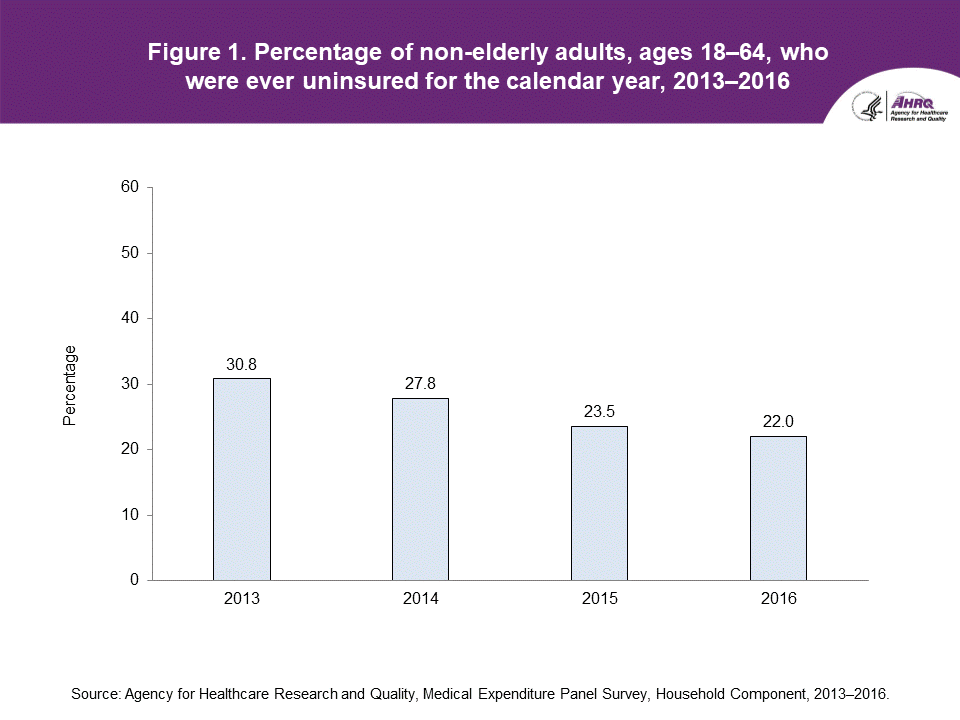
| Calendar year | 2013 | 2014 | 2015 | 2016 |
|---|---|---|---|---|
| Uninsured | 30.8 | 27.8 | 23.5 | 22.0 |
|
Source: Agency for Healthcare Research and Quality, Medical Expenditure Panel Survey, Household Component, 2013–2016. |
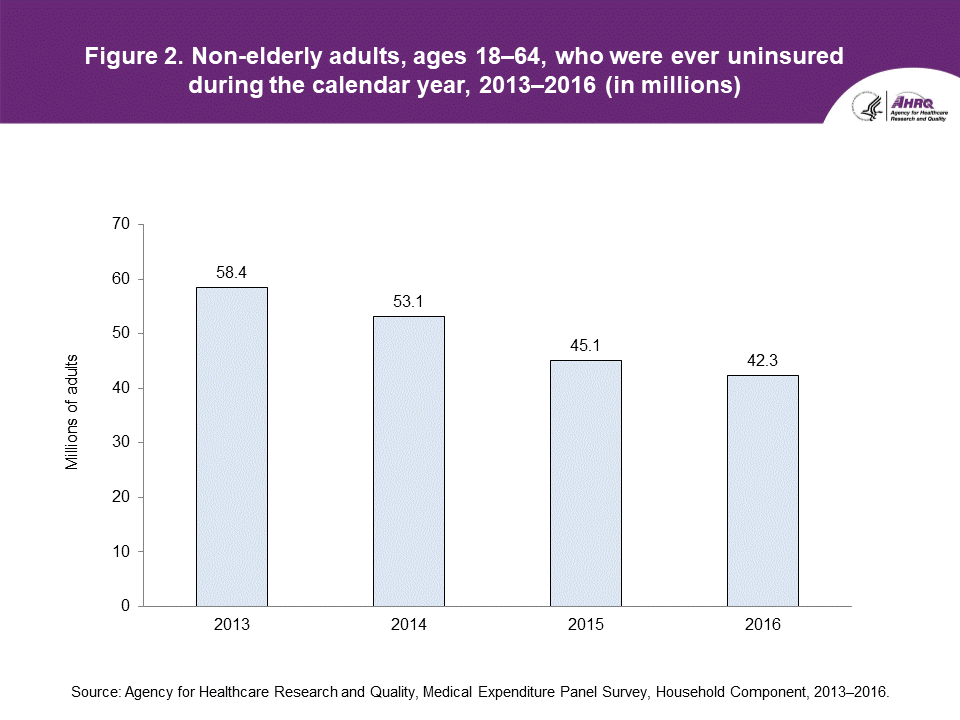
| Calendar year | 2013 | 2014 | 2015 | 2016 |
|---|---|---|---|---|
| Uninsured | 58.4 | 53.1 | 45.1 | 42.3 |
|
Source: Agency for Healthcare Research and Quality, Medical Expenditure Panel Survey, Household Component, 2013–2016. |
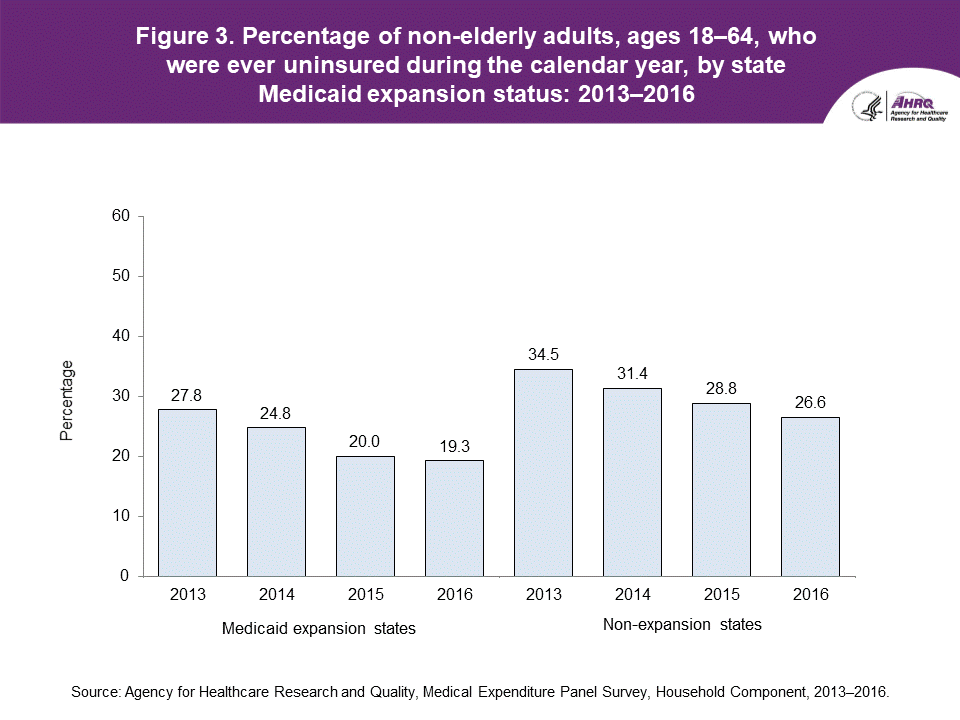
| Expansion status | Medicaid expansion states | Non-expansion states | ||||||
|---|---|---|---|---|---|---|---|---|
| Calendar year | 2013 | 2014 | 2015 | 2016 | 2013 | 2014 | 2015 | 2016 |
| Overall | 27.8 | 24.8 | 20.0 | 19.3 | 34.5 | 31.4 | 28.8 | 26.6 |
|
Source: Agency for Healthcare Research and Quality, Medical Expenditure Panel Survey, Household Component, 2013–2016. |
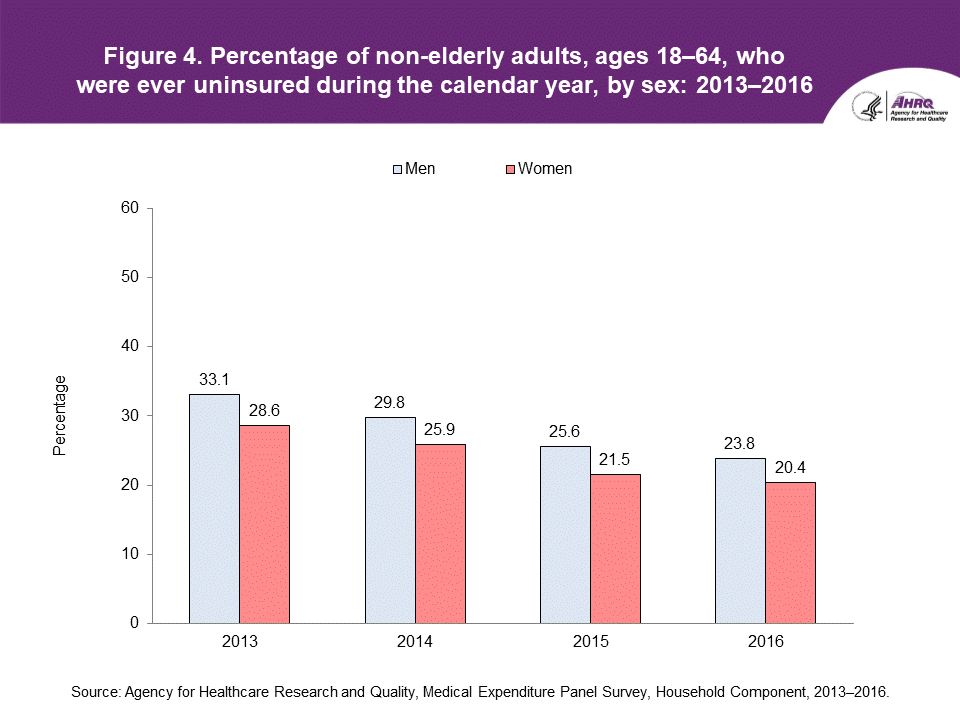
| Calendar year | 2013 | 2014 | 2015 | 2016 |
|---|---|---|---|---|
| Men | 33.1 | 29.8 | 25.6 | 23.8 |
| Women | 28.6 | 25.9 | 21.5 | 20.4 |
|
Source: Agency for Healthcare Research and Quality, Medical Expenditure Panel Survey, Household Component, 2013–2016. |

| Expansion status | Medicaid expansion states | Non-expansion states | ||||||
|---|---|---|---|---|---|---|---|---|
| Calendar year | 2013 | 2014 | 2015 | 2016 | 2013 | 2014 | 2015 | 2016 |
| Men | 30.2 | 27.6 | 22.3 | 20.9 | 36.5 | 32.4 | 30.6 | 28.6 |
| Women | 25.5 | 22.2 | 17.8 | 17.7 | 32.5 | 30.4 | 27.1 | 24.7 |
|
Source: Agency for Healthcare Research and Quality, Medical Expenditure Panel Survey, Household Component, 2013–2016. |
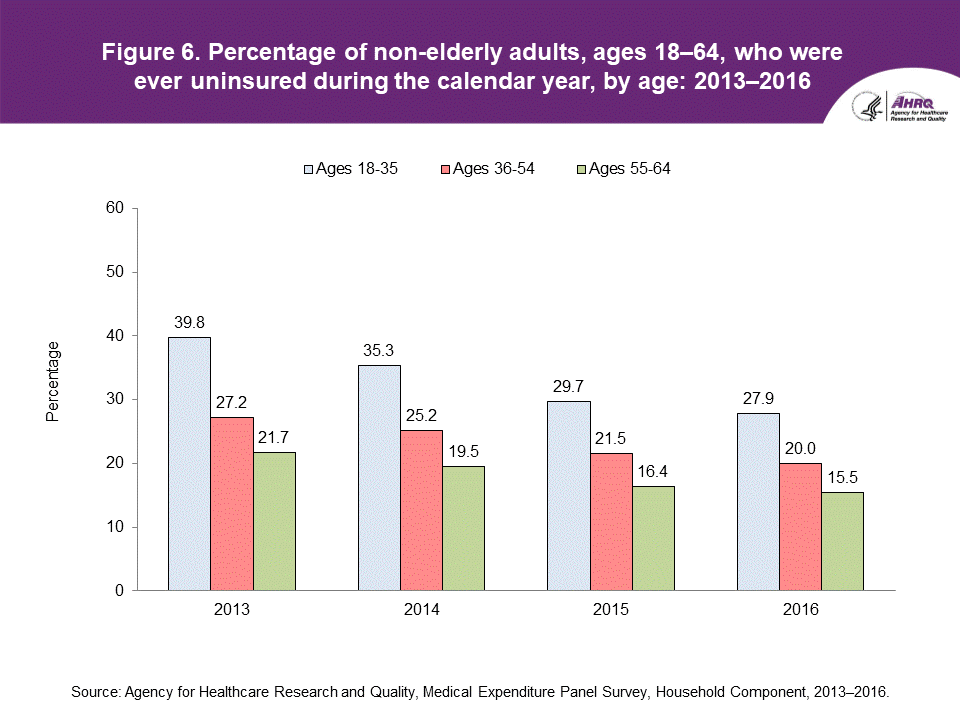
| Calendar year | 2013 | 2014 | 2015 | 2016 |
|---|---|---|---|---|
| Ages 18–35 | 39.8 | 35.3 | 29.7 | 27.9 |
| Ages 36–54 | 27.2 | 25.2 | 21.5 | 20.0 |
| Ages 55–64 | 21.7 | 19.5 | 16.4 | 15.5 |
|
Source: Agency for Healthcare Research and Quality, Medical Expenditure Panel Survey, Household Component, 2013–2016. |
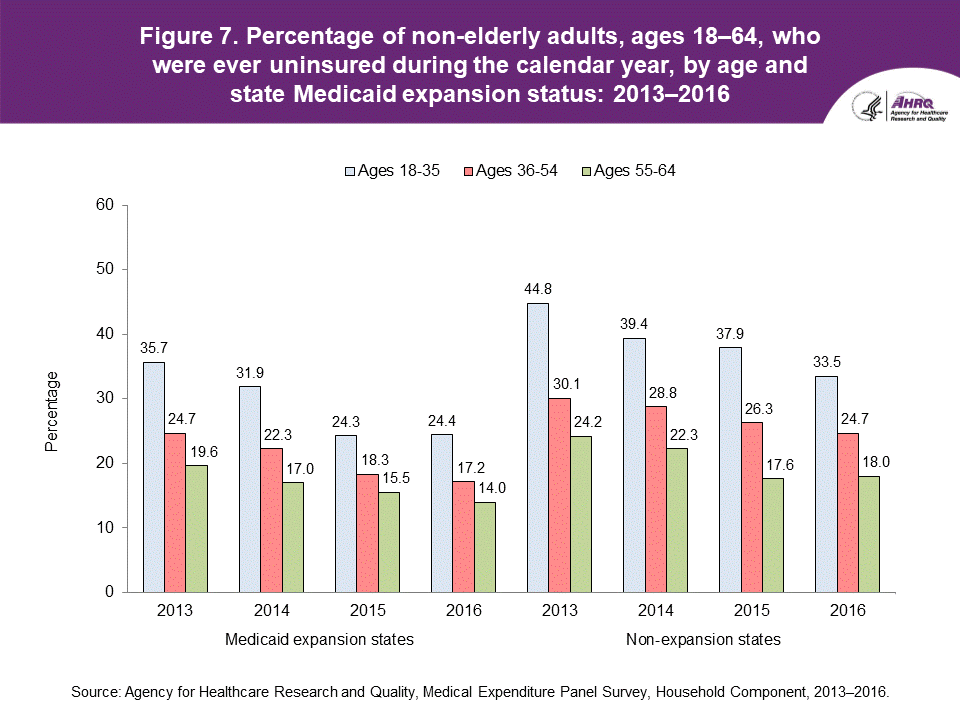
| Expansion status | Medicaid expansion states | Non-expansion states | ||||||
|---|---|---|---|---|---|---|---|---|
| Calendar year | 2013 | 2014 | 2015 | 2016 | 2013 | 2014 | 2015 | 2016 |
| Ages 18–35 | 35.7 | 31.9 | 24.3 | 24.4 | 44.8 | 39.4 | 37.9 | 33.5 |
| Ages 36–54 | 24.7 | 22.3 | 18.3 | 17.2 | 30.1 | 28.8 | 26.3 | 24.7 |
| Ages 55–64 | 19.6 | 17.0 | 15.5 | 14.0 | 24.2 | 22.3 | 17.6 | 18.0 |
|
Source: Agency for Healthcare Research and Quality, Medical Expenditure Panel Survey, Household Component, 2013–2016. |
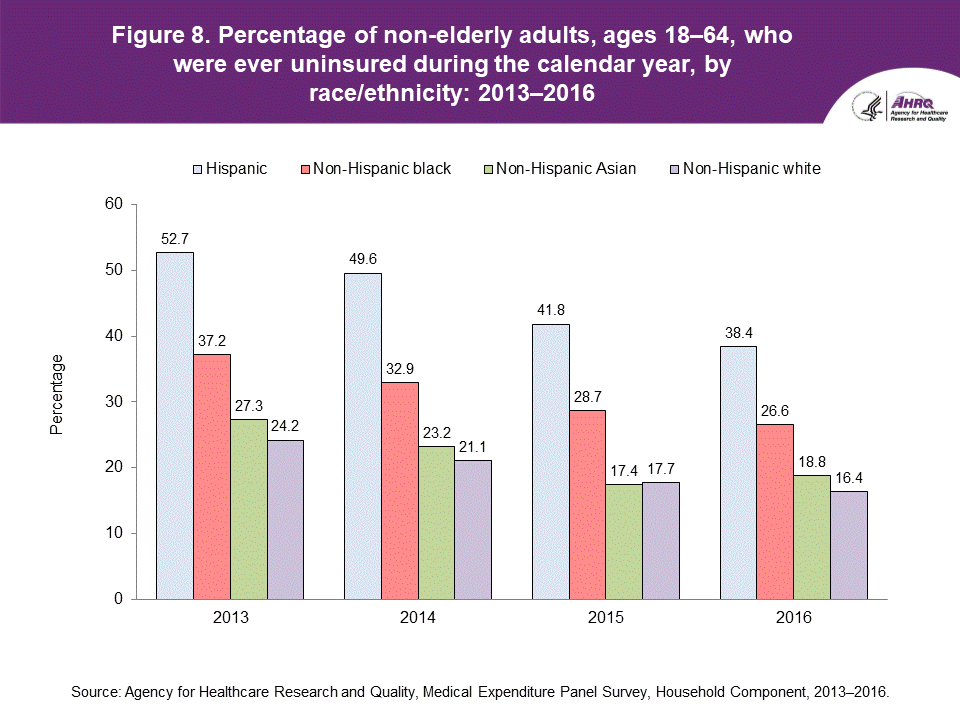
| Calendar year | 2013 | 2014 | 2015 | 2016 |
|---|---|---|---|---|
| Hispanic | 52.7 | 49.6 | 41.8 | 38.4 |
| Non-Hispanic black | 37.2 | 32.9 | 28.7 | 26.6 |
| Non-Hispanic Asian | 27.3 | 23.2 | 17.4 | 18.8 |
| Non-Hispanic white | 24.2 | 21.1 | 17.7 | 16.4 |
|
Source: Agency for Healthcare Research and Quality, Medical Expenditure Panel Survey, Household Component, 2013–2016. |
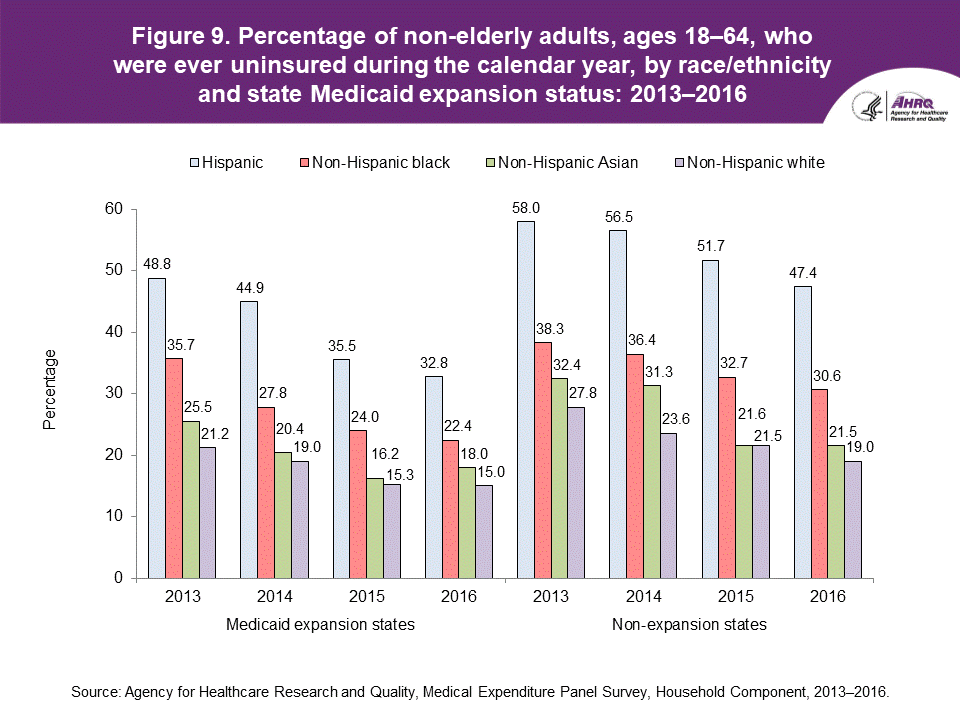
| Expansion status | Medicaid expansion states | Non-expansion states | ||||||
|---|---|---|---|---|---|---|---|---|
| Calendar year | 2013 | 2014 | 2015 | 2016 | 2013 | 2014 | 2015 | 2016 |
| Hispanic | 48.8 | 44.9 | 35.5 | 32.8 | 58.0 | 56.5 | 51.7 | 47.4 |
| Non-Hispanic black | 35.7 | 27.8 | 24.0 | 22.4 | 38.3 | 36.4 | 32.7 | 30.6 |
| Non-Hispanic Asian | 25.5 | 20.4 | 16.2 | 18.0 | 32.4 | 31.3 | 21.6 | 21.5 |
| Non-Hispanic white | 21.2 | 19.0 | 15.3 | 15.0 | 27.8 | 23.6 | 21.5 | 19.0 |
|
Source: Agency for Healthcare Research and Quality, Medical Expenditure Panel Survey, Household Component, 2013–2016. |

| Calendar year | 2013 | 2014 | 2015 | 2016 |
|---|---|---|---|---|
| No HS diploma | 51.8 | 48.2 | 43.8 | 41.3 |
| HS diploma/GED | 37.7 | 34.6 | 28.6 | 25.4 |
| Some college | 31.1 | 27.7 | 22.3 | 17.8 |
| College degree or more | 14.9 | 13.8 | 11.8 | 10.9 |
|
Source: Agency for Healthcare Research and Quality, Medical Expenditure Panel Survey, Household Component, 2013–2016. |
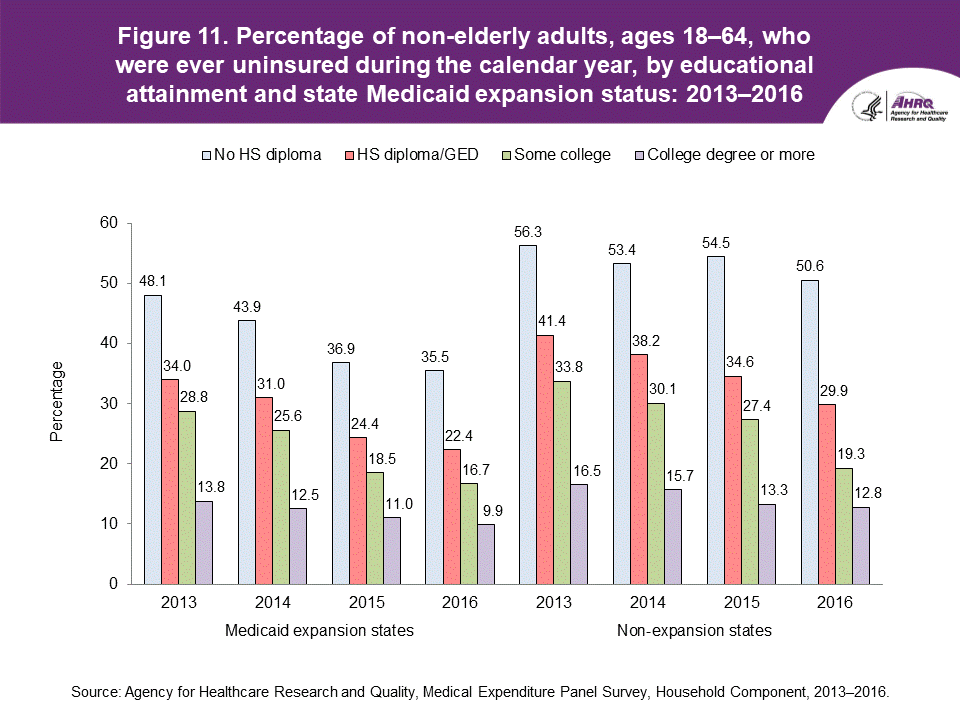
| Expansion status | Medicaid expansion states | Non-expansion states | ||||||
|---|---|---|---|---|---|---|---|---|
| Calendar year | 2013 | 2014 | 2015 | 2016 | 2013 | 2014 | 2015 | 2016 |
| No HS diploma | 48.1 | 43.9 | 36.9 | 35.5 | 56.3 | 53.4 | 54.5 | 50.6 |
| HS diploma/GED | 34.0 | 31.0 | 24.4 | 22.4 | 41.4 | 38.2 | 34.6 | 29.9 |
| Some college | 28.8 | 25.6 | 18.5 | 16.7 | 33.8 | 30.1 | 27.4 | 19.3 |
| College degree or more | 13.8 | 12.5 | 11.0 | 9.9 | 16.5 | 15.7 | 13.3 | 12.8 |
|
Source: Agency for Healthcare Research and Quality, Medical Expenditure Panel Survey, Household Component, 2013–2016. |
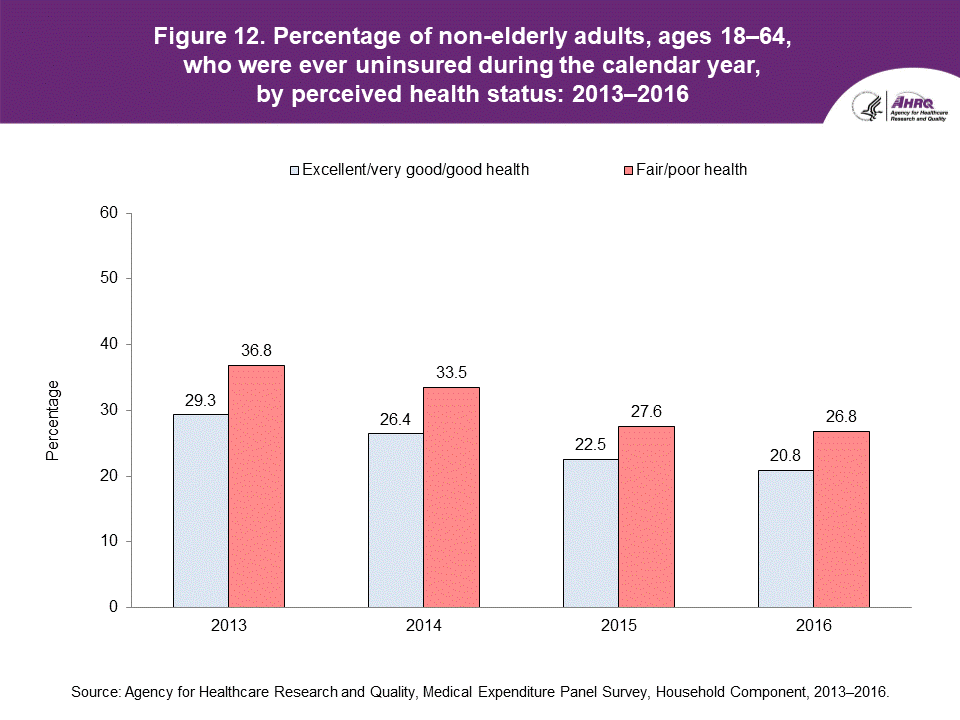
| Calendar year | 2013 | 2014 | 2015 | 2016 |
|---|---|---|---|---|
| Excellent/very good/good health | 29.3 | 26.4 | 22.5 | 20.8 |
| Fair/poor health | 36.8 | 33.5 | 27.6 | 26.8 |
|
Source: Agency for Healthcare Research and Quality, Medical Expenditure Panel Survey, Household Component, 2013–2016. |
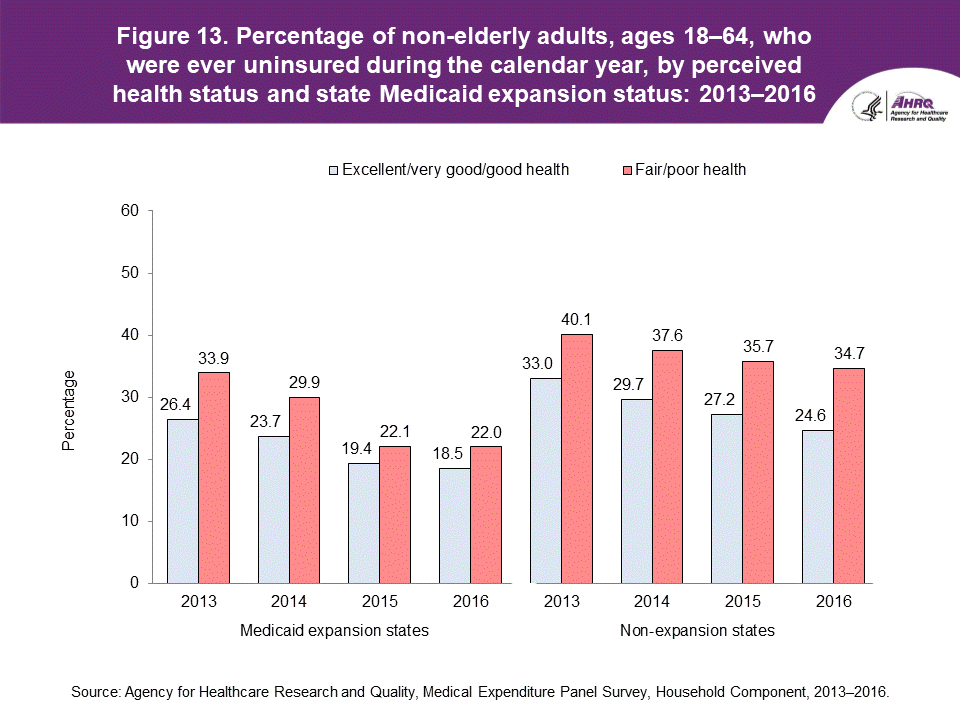
| Expansion status | Medicaid expansion states | Non-expansion states | ||||||
|---|---|---|---|---|---|---|---|---|
| Calendar year | 2013 | 2014 | 2015 | 2016 | 2013 | 2014 | 2015 | 2016 |
| Excellent/very good/good health | 26.4 | 23.7 | 19.4 | 18.5 | 33.0 | 29.7 | 27.2 | 24.6 |
| Fair/poor health | 33.9 | 29.9 | 22.1 | 22.0 | 40.1 | 37.6 | 35.7 | 34.7 |
|
Source: Agency for Healthcare Research and Quality, Medical Expenditure Panel Survey, Household Component, 2013–2016. |
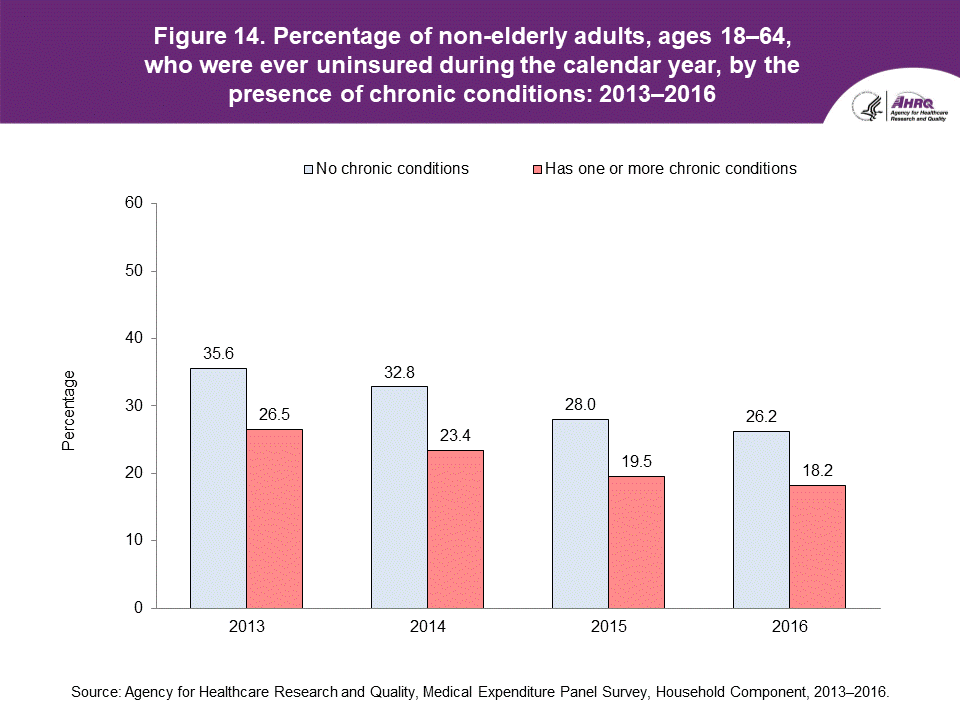
| Calendar year | 2013 | 2014 | 2015 | 2016 |
|---|---|---|---|---|
| No chronic conditions | 35.6 | 32.8 | 28.0 | 26.2 |
| Has one or more chronic conditions | 26.5 | 23.4 | 19.5 | 18.2 |
|
Source: Agency for Healthcare Research and Quality, Medical Expenditure Panel Survey, Household Component, 2013–2016. |
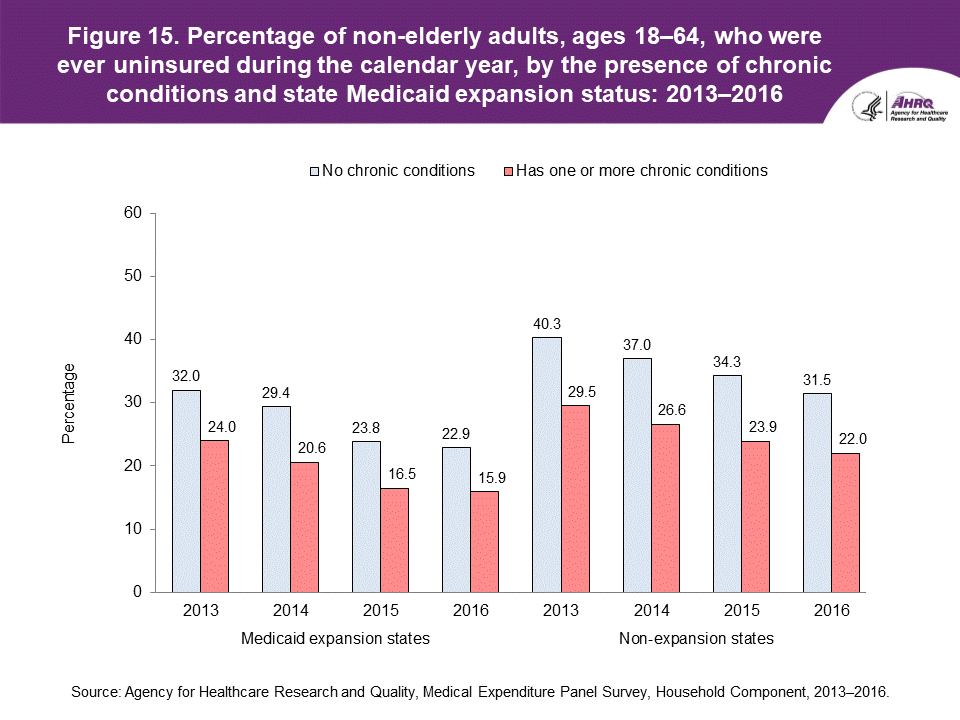
| Expansion status | Medicaid expansion states | Non-expansion states | ||||||
|---|---|---|---|---|---|---|---|---|
| Calendar year | 2013 | 2014 | 2015 | 2016 | 2013 | 2014 | 2015 | 2016 |
| No chronic conditions | 32.0 | 29.4 | 23.8 | 22.9 | 40.3 | 37.0 | 34.3 | 31.5 |
| Has one or more chronic conditions | 24.0 | 20.6 | 16.5 | 15.9 | 29.5 | 26.6 | 23.9 | 22.0 |
|
Source: Agency for Healthcare Research and Quality, Medical Expenditure Panel Survey, Household Component, 2013–2016. |


